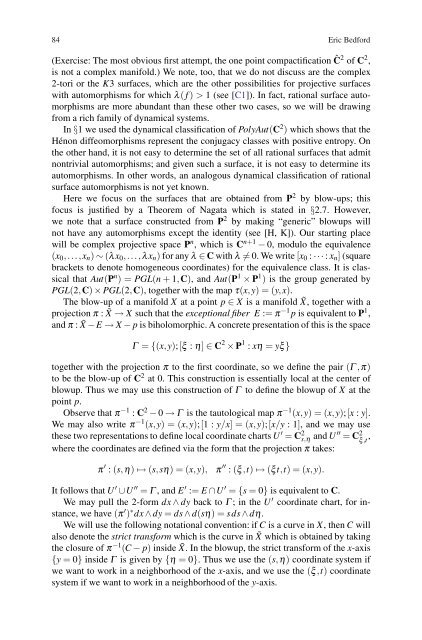Discrete Holomorphic Local Dynamical Systems
Discrete Holomorphic Local Dynamical Systems
Discrete Holomorphic Local Dynamical Systems
You also want an ePaper? Increase the reach of your titles
YUMPU automatically turns print PDFs into web optimized ePapers that Google loves.
84 Eric Bedford<br />
(Exercise: The most obvious first attempt, the one point compactification Ĉ 2 of C 2 ,<br />
is not a complex manifold.) We note, too, that we do not discuss are the complex<br />
2-tori or the K3 surfaces, which are the other possibilities for projective surfaces<br />
with automorphisms for which λ ( f ) > 1(see[C1]). In fact, rational surface automorphisms<br />
are more abundant than these other two cases, so we will be drawing<br />
from a rich family of dynamical systems.<br />
In §1 we used the dynamical classification of PolyAut(C 2 ) which shows that the<br />
Hénon diffeomorphisms represent the conjugacy classes with positive entropy. On<br />
the other hand, it is not easy to determine the set of all rational surfaces that admit<br />
nontrivial automorphisms; and given such a surface, it is not easy to determine its<br />
automorphisms. In other words, an analogous dynamical classification of rational<br />
surface automorphisms is not yet known.<br />
Here we focus on the surfaces that are obtained from P 2 by blow-ups; this<br />
focus is justified by a Theorem of Nagata which is stated in §2.7. However,<br />
we note that a surface constructed from P 2 by making “generic” blowups will<br />
not have any automorphisms except the identity (see [H, K]). Our starting place<br />
will be complex projective space P n ,whichisC n+1 − 0, modulo the equivalence<br />
(x0,...,xn) ∼ (λ x0,...,λ xn) for any λ ∈ C with λ �= 0. We write [x0 : ···: xn] (square<br />
brackets to denote homogeneous coordinates) for the equivalence class. It is classical<br />
that Aut(P n )=PGL(n + 1,C), andAut(P 1 × P 1 ) is the group generated by<br />
PGL(2,C) × PGL(2,C), together with the map τ(x,y)=(y,x).<br />
The blow-up of a manifold X at a point p ∈ X is a manifold ˜X, together with a<br />
projection π : ˜X → X such that the exceptional fiber E := π −1 p is equivalent to P 1 ,<br />
and π : ˜X −E → X − p is biholomorphic. A concrete presentation of this is the space<br />
Γ = {(x,y);[ξ : η] ∈ C 2 × P 1 : xη = yξ }<br />
together with the projection π to the first coordinate, so we define the pair (Γ ,π)<br />
to be the blow-up of C 2 at 0. This construction is essentially local at the center of<br />
blowup. Thus we may use this construction of Γ to define the blowup of X at the<br />
point p.<br />
Observe that π −1 : C 2 − 0 → Γ is the tautological map π −1 (x,y)=(x,y);[x : y].<br />
We may also write π −1 (x,y) =(x,y);[1 :y/x] =(x,y);[x/y :1], andwemayuse<br />
these two representations to define local coordinate charts U ′ = C 2 s,η and U ′′ = C 2 ξ ,t ,<br />
where the coordinates are defined via the form that the projection π takes:<br />
π ′ : (s,η) ↦→ (s,sη)=(x,y), π ′′ : (ξ ,t) ↦→ (ξt,t)=(x,y).<br />
It follows that U ′ ∪U ′′ = Γ ,andE ′ := E ∩U ′ = {s = 0} is equivalent to C.<br />
We may pull the 2-form dx∧ dy back to Γ ;intheU ′ coordinate chart, for instance,<br />
we have (π ′ ) ∗ dx∧ dy = ds∧ d(sη)=sds∧ dη.<br />
We will use the following notational convention: if C is a curve in X,thenC will<br />
also denote the strict transform which is the curve in ˜X which is obtained by taking<br />
the closure of π −1 (C − p) inside ˜X. In the blowup, the strict transform of the x-axis<br />
{y = 0} inside Γ is given by {η = 0}. Thus we use the (s,η) coordinate system if<br />
we want to work in a neighborhood of the x-axis, and we use the (ξ ,t) coordinate<br />
system if we want to work in a neighborhood of the y-axis.



